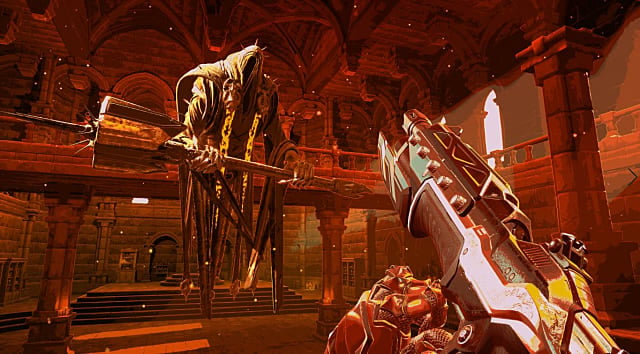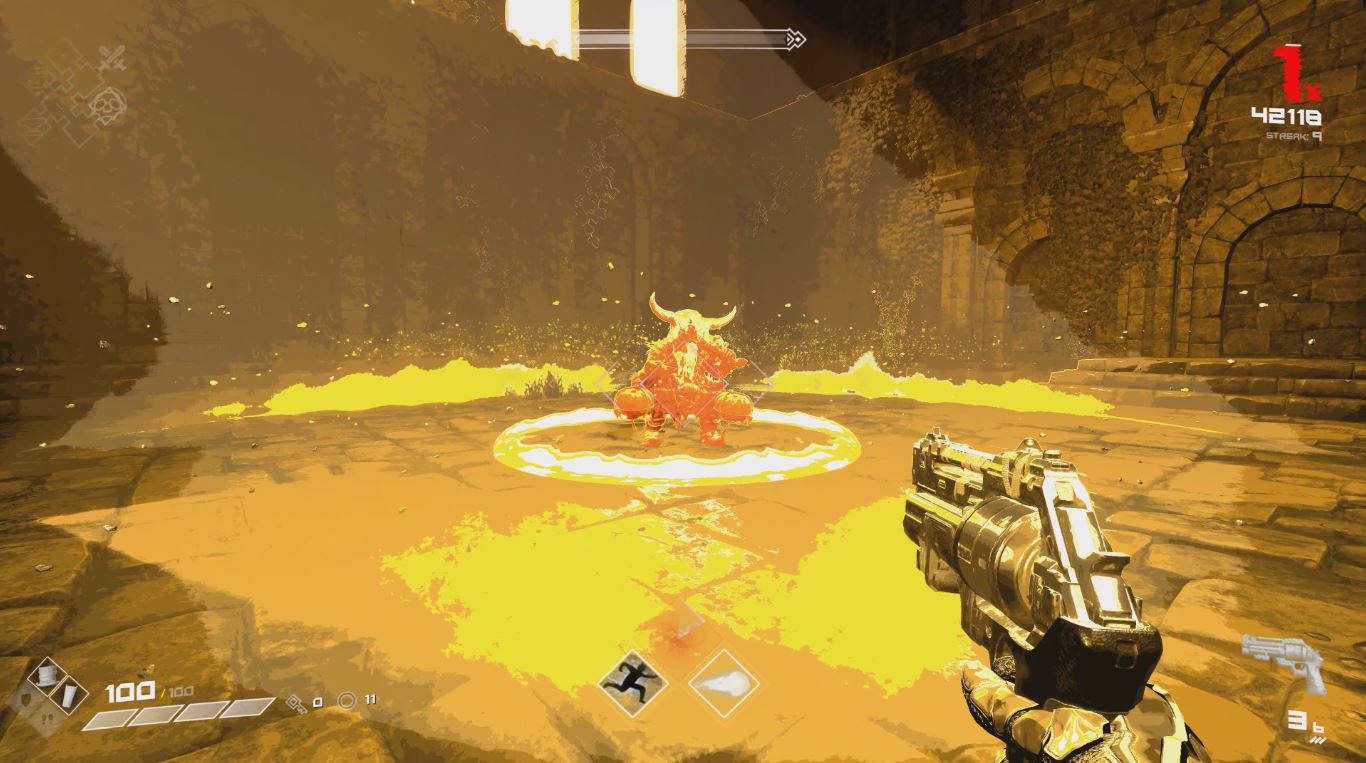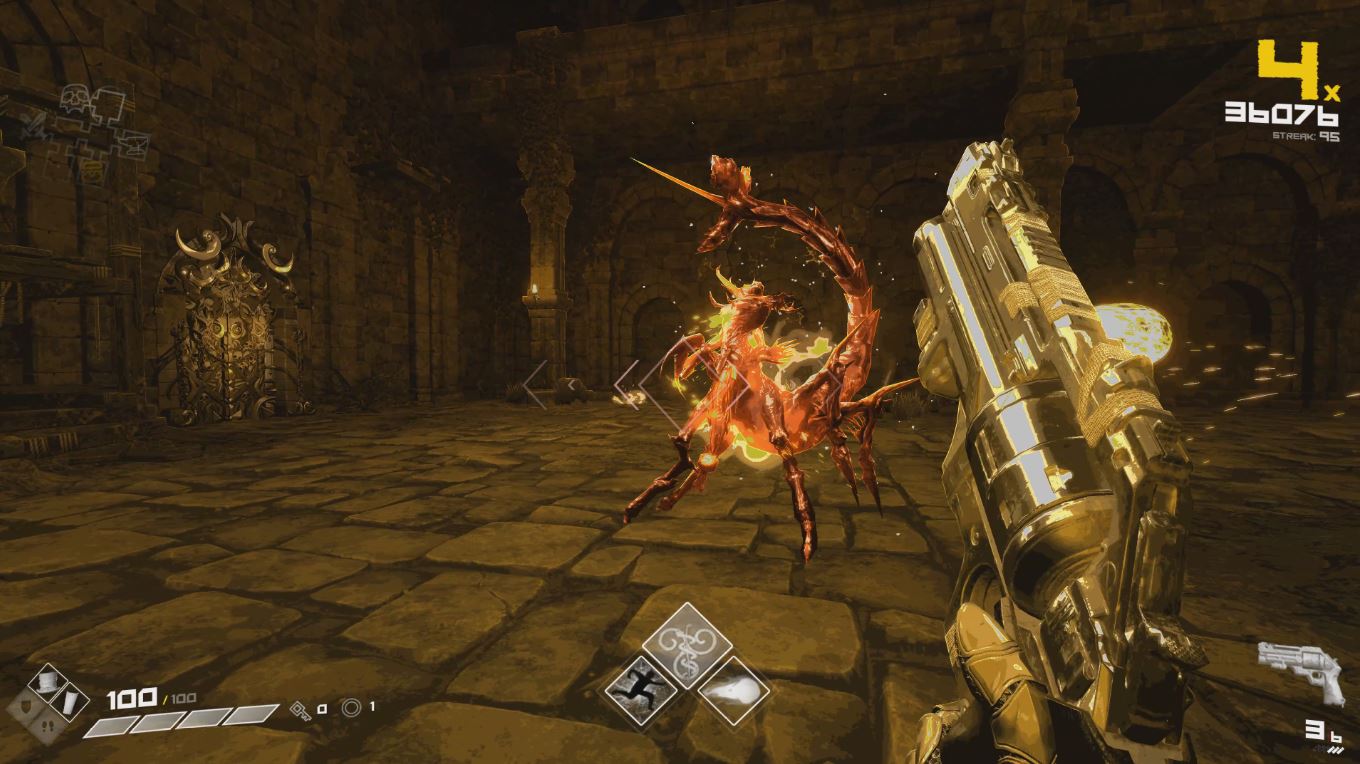Results can vary when genres are mixed together, but in the case of BPM: Bullets Per Minute, that mixture walks its fine line beautifully. Developed by Awe Interactive, BPM is what happens when you mix Doom Eternal with Crypt of the Necrodancer, working as an FPS with both rhythm and roguelike elements.
(Bullet) dancing in sync to a heavy rock soundtrack, BPM: Bullets Per Minute is a fantastic experience that presents a significant challenge.
BPM: Bullets Per Minute Review — Musical Doom
To survive, you must keep moving.
BPM isn’t a story-heavy experience, though you’ll play as a Valkyrie sent to stop the Underworld’s invasion of Asgard. You’ll unlock other characters as you advance through the game’s four procedurally generated dungeons, all of which are divided into small sub-sections with different layouts for each run.
Every section ends with a mini-boss fight, with your journey culminating in a final target. For those looking for added variety to BPM‘s more roguelike elements, the rhythm shooter also comes with a series of unlockable challenges, such as a retro mode that’s a clear throwback to classic Doom.
BPM doesn’t offer up any tutorials. Instead, it tosses you straight into the deep end, becoming a literal trial by fire. Whether it’s reloading or shooting, every action (or bar movement) must be timed to the beat, with enemies following that same tempo. To survive, you must keep moving.
Whether it’s a tiny bat hidden just behind a pillar or hefty spider charging right at you, each encounter feels like a lead-laden performance, seeing you weave rhythmically amongst and between enemies. Killing those enemies earns you points, and rattling off a few bad guys in quick succession builds up your score multiplier.
Once a room is cleared, your performance is judged, and a chest of rewards is offered, which can range from coins to new weaponry. Most areas feature small shrines, too, that are admittedly easy to miss during the intense action. But you won’t want to miss them. Offering a coin at a shrine will provide you with a stat buff (which one comes down to said shrine), and they can improve attributes like speed, range, luck, damage, precision, and ability.
If you aren’t careful, you’ll die quite a bit, and that means restarting your entire dungeon run, which removes any earned upgrades. Easy and hard difficulties are available, but even easy mode provides a fair, though sometimes unforgiving, challenge. While losing your progress is a foundational element in roguelites and roguelikes, doing so in BPM does get frustrating from time to time.
Ultimately, though, things fall into place because what truly brings BPM to life is its core gameplay loop.
[BPM is] one title rhythm fans would do well to put on their playlist.
Outside of VR experiences like Pistol Whip, you rarely see FPS games blend rhythm elements into their core design, but BPM does it well, and combat flows naturally. This feeling of fluidity is helped by an intense soundtrack, which goes from heavy electro-rock to metal, and Awe has done a fantastic job piecing the head-banging score together.
For those struggling with the game’s rhythm aspects, there are thankfully a number of options that improve BPM‘s general accessibility. If you want a more significant challenge, you can make rhythm detection stricter; if you want a lesser challenge, rhythm detection can be dialed down. There’s also an Auto Rhythm mode, which negates the need to line up your shots but disables your score multiplier.
Dependent on how your dungeons generate, numerous “help areas” may also appear. Random additions include banks for storing coins between deaths, libraries for picking up ultimate attack abilities, treasure rooms for grabbing rare (and useful) loot, blacksmiths for buying better weaponry, and general shops for acquiring health and defense items. The latter even employs a type of loyalty scheme, where the more you spend over time, the more items are on offer.
Boss rooms tend to appear relatively quickly as you advance, so it pays to explore dungeons before diving into these and ensuring your character is at full strength.
BPM: Bullets Per Minute Review — The Bottom Line
Pros
- Incredible soundtrack
- Merges rhythm and action well
- Genuinely satisfying combat
Cons
- Challenge may be off-putting for some
- Roguelite mechanics are all too familiar
Mixing FPS combat with the pulse of a rhythm game may not sound like a recipe for success, but BPM: Bullets Per Minute delivers on its approach with a beautiful soundtrack supporting it.
It’s not a forgiving experience, and though it’s difficult to master, BPM proves surprisingly easy to pick up and play. If you’re prepared to die a lot, you’ll find an incredible game within, and it’s one title rhythm fans would do well to put on their playlist.
[Note: Awe Interactive provided the copy of BPM: Bullets Per Minute used for this review.]









Published: Sep 14, 2020 11:29 am